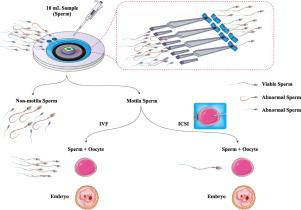Life Sciences ( IF 5.2 ) Pub Date : 2020-11-16 , DOI: 10.1016/j.lfs.2020.118767 Aylin Nikshad , Afsoon Aghlmandi , Reza Safaralizadeh , Leili Aghebati-Maleki , Majid Ebrahimi Warkiani , Farhad Motavalli Khiavi , Mehdi Yousefi

|
According to World Health Organization (WHO) reports about 70 million couples suffer from infertility all over the world. A lot of research groups are working on this issue and have made therapeutic approaches by integrating biology, medicine, genetics, chemistry, psychology, mechanic, and many other branches of science. However, these methods have their own pros and cons. Assisted Reproductive Technologies (Bhattacharya et al., 2001 [1]) has appeared to solve infertility problems. In Vitro Fertilization (IVF), Intracytoplasmic Sperm Injection (ICSI), Intrauterine Insemination (IUI) are the most common and conventional technologies in this regard. There are at least two characteristics of microfluidics, mechanical and biochemical, which can be influential in the field of mammalian gamete and preimplantation embryo biology. These microfluidic characteristics can assist in basic biological studies on sperm, oocyte and preimplantation embryo structure, function and environment. Using microfluidics in sorting sperm, conducting different steps of oocyte selection and preparation, and transferring embryo by passing sub-microliter fluid through microchannels results in low cost and short time. The size and shape of microchannels and the volume of used fluid differs from non-human cells to human cells. The most progressions have been seen in animal models. Results suggest that microfluidic systems will lead to improved efficiencies in assisted reproduction.
中文翻译:

生殖生物学中的微流控技术进展
根据世界卫生组织(WHO)的报告,全世界大约有7,000万对夫妇患有不孕症。许多研究小组正在研究这个问题,并通过整合生物学,医学,遗传学,化学,心理学,机械学和许多其他科学分支来制定治疗方法。但是,这些方法各有利弊。辅助生殖技术(Bhattacharya等,2001 [1])似乎可以解决不孕问题。在这方面,体外受精(IVF),胞浆内精子注射(ICSI),宫内授精(IUI)是最常见和常规的技术。微流体的至少两个特征是机械的和生物化学的,这在哺乳动物配子和植入前胚胎生物学领域可能具有影响力。这些微流体特性可有助于精子,卵母细胞和植入前胚胎的结构,功能和环境的基础生物学研究。使用微流控技术对精子进行分选,进行卵母细胞选择和制备的不同步骤,以及通过将亚微升液通过微通道转移胚胎,可降低成本并缩短时间。从非人类细胞到人类细胞,微通道的大小和形状以及所用液体的量都不同。在动物模型中观察到最多的进展。结果表明,微流体系统将导致辅助生殖的效率提高。进行卵母细胞选择和制备的不同步骤,并通过将亚微升液流过微通道来转移胚胎,导致成本低,时间短。从非人类细胞到人类细胞,微通道的大小和形状以及所用液体的量都不同。在动物模型中观察到最多的进展。结果表明,微流体系统将导致辅助生殖的效率提高。进行卵母细胞选择和制备的不同步骤,并通过将亚微升液流过微通道来转移胚胎,导致成本低,时间短。从非人类细胞到人类细胞,微通道的大小和形状以及所用液体的量都不同。在动物模型中观察到最多的进展。结果表明,微流体系统将导致辅助生殖的效率提高。










































 京公网安备 11010802027423号
京公网安备 11010802027423号